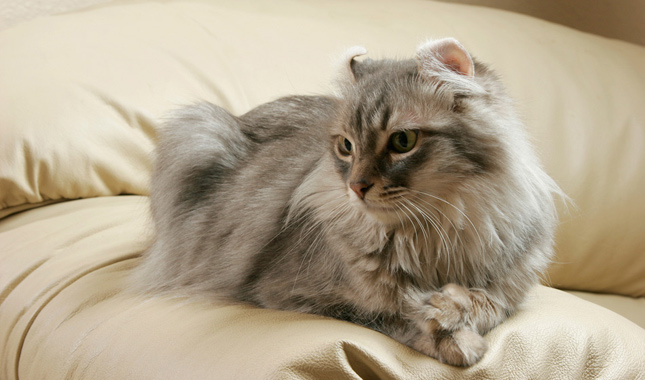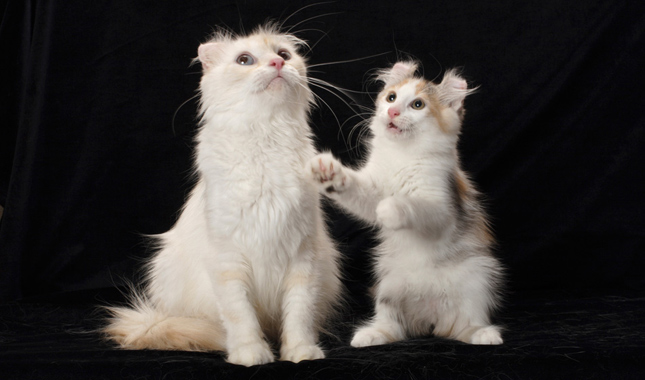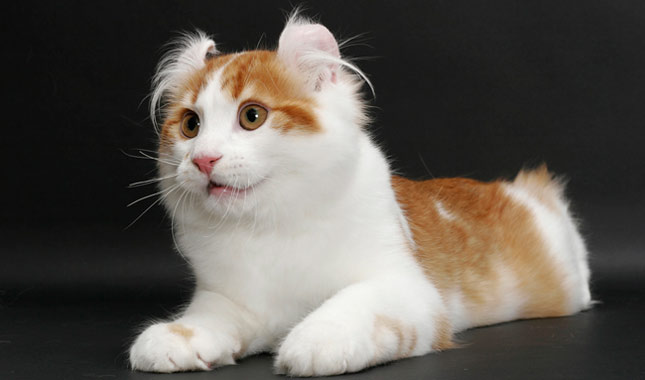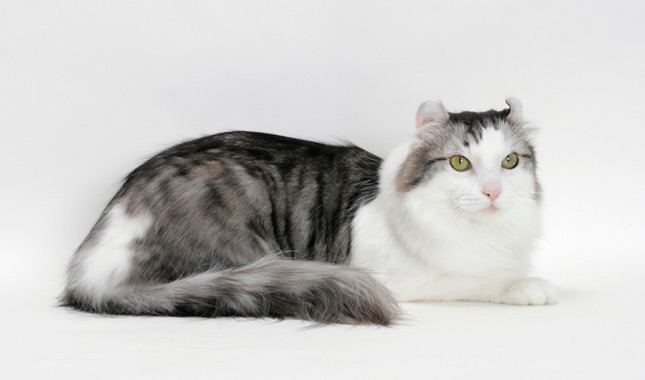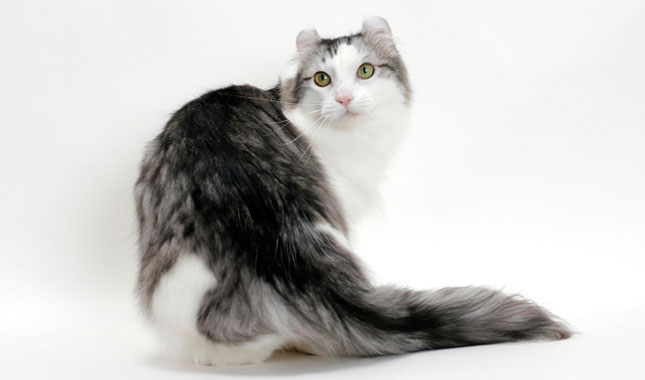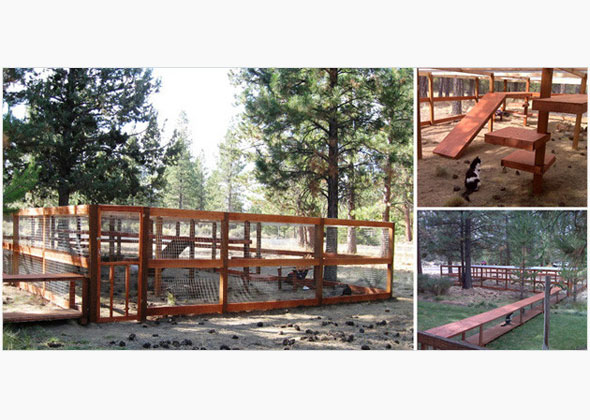American Curl
Published on June 22, 2011
Skip To
Breed Characteristics
Adaptability
Energy Level
Child Friendly
Social Needs
Shedding Level
Grooming
Health Issues
Stranger Friendly
Affectionate
Dog Friendly
Intelligence
The signature characteristic of the Curl is his unusual ears, which curl backward instead of standing up and coming to a point. The American Curl is a medium-size cat weighing five to 10 pounds, with an average lifespan of more than 13 years.
The American Curl is the product of a spontaneous natural mutation, a not uncommon occurrence in the world of cats. But his name doesn’t refer to his coat, which can be shorthaired or longhaired. Instead, it’s a shoutout to his backward-curling ears, adorned with long tufts of fur, which give him the appearance of being surprised by joy.
The first known Curl cat made his appearance in the early 1980s. Cat breeders eventually took an interest in this twist of nature, and he was developed into a breed.
True to his expression, the American Curl is a joyous cat. This medium-size cat loves to play, even well into old age, and it’s not unusual for him to enjoy playing fetch. Like any cat, he is most often found perching in high places; that is, when he’s not perched on your lap or following you around.
He is sociable, loving, and family-oriented, often with a special fondness for children. He is a good choice for families with older children who will treat him respectfully, but toddlers should be supervised so they don’t manhandle him. The Curl is also perfectly capable of getting along with other cats or with cat-friendly dogs in the household.
Because he is so friendly, the Curl doesn’t like being left alone for long periods, so consider your schedule and the presence or absence of other pets before you bring one of these cats home. You don’t want him to develop separation anxiety.
The American Curl is well suited to any home with people who will love and care for him. Keep him indoors to protect him from cars, diseases spread by other cats, and attacks from other animals.
It all began on a hot June day in 1981, when a stray longhaired black female kitten with unusual ears who moved in with Joe and Grace Ruga of Lakewood, California. They named her Shulamith. A few months later, the affectionate Shulamith repaid the Rugas’ kindness with a litter of four kittens. Two of them shared their mother’s distinctive trait. And thus was born a breed, with all American Curls tracing back to Shulamith.
Cat breeders around the world were fascinated by the new development. By 1983 they had begun selective breeding programs to preserve the characteristic. Feline geneticist Roy Robinson determined that the ear-curling gene was autosomal dominant, meaning that a cat with even one copy of the gene would have ears that curled back.
In an unusually rapid rise from stray to star, the American Curl was recognized by The International Cat Association in 1987 — just five years after the first breeding programs began — and by the Cat Fanciers Association in 1993.
He is sociable, loving, and family oriented, often with a special fondness for children. He is a good choice for families with older children who will treat him respectfully, but toddlers should be supervised so they don’t manhandle him. The Curl is also perfectly capable of getting along with other cats or cat-friendly dogs in the household.
The Curl is highly intelligent. Challenge his brain by teaching him tricks and providing him with puzzle toys that will reward him with kibble or treats when he learns to manipulate them.
Always choose a kitten from a breeder who raises litters in her home and handles them from an early age. Meet at least one and ideally both of the parents to find out if they have nice temperaments.
Remember that after you’ve taken a new kitten into your home, you have the power to protect him from one of the most common health problems: obesity. Keeping an American Curl at an appropriate weight is one of the easiest ways to protect his overall health. Make the most of your preventive abilities to help ensure a healthier cat for life.
The only other grooming the American Curl needs is regular nail trimming, usually weekly. Brush the teeth frequently with a vet-approved pet toothpaste for good overall health and fresh breath. Start nail trimming and teeth brushing early so your kitten becomes accepting of this activity.
Check the ears weekly for redness or a bad smell that could indicate an infection. Clean the ears only if they look dirty. Use a gentle cleanser recommended by your veterinarian. Never fold or force the ear into other positions, as this can damage the cartilage.
Put at least as much effort into researching your kitten as you would into choosing a new car or expensive appliance. It will save you money in the long run.
A reputable breeder will abide by a code of ethics that prohibits sales to pet stores and wholesalers and outlines the breeder’s responsibilities to their cats and to buyers. Choose a breeder who has performed the health certifications necessary to screen out genetic health problems to the extent that is possible, as well as one who raises kittens in the home. Kittens who are isolated can become fearful and skittish and may be difficult to socialize later in life.
Lots of reputable breeders have websites, so how can you tell who’s good and who’s not? Red flags include kittens always being available, multiple litters on the premises, having your choice of any kitten, and the ability to pay online with a credit card. Those things are convenient, but they are almost never associated with reputable breeders.
Whether you’re planning to get your feline friend from a breeder, a pet store, or another source, don’t forget that old adage “let the buyer beware”. Disreputable breeders and unhealthy catteries can be hard to distinguish from reliable operations. There’s no 100% guaranteed way to make sure you’ll never purchase a sick kitten, but researching the breed (so you know what to expect), checking out the facility (to identify unhealthy conditions or sick animals), and asking the right questions can reduce the chances of heading into a disastrous situation. And don’t forget to ask your veterinarian, who can often refer you to a reputable breeder, breed rescue organization, or other reliable source for healthy kittens.
Be patient. Depending on what you are looking for, you may have to wait six months or more for the right kitten to become available. Many breeders won’t release kittens to their new homes until they are between 12 and 16 weeks of age.
Before you buy a kitten, consider whether an adult American Curl might be a better choice for your lifestyle. Kittens are loads of fun, but they’re also a lot of work and can be destructive until they reach a somewhat more sedate adulthood. With an adult, you know exactly what you’re getting in terms of personality and health. If you are interested in acquiring an adult cat instead of a kitten, ask breeders about purchasing a retired show or breeding cat or if they know of an adult cat who needs a new home.
Here are some tips to help you find and adopt the right cat from a rescue group or shelter.
1. Use the Web
Sites like Petfinder.com and Adopt-a-Pet.com can have you searching for a American Curl in your area in no time. The site allows you to be very specific in your requests (housetraining status, for example) or very general (all the American Curls available on Petfinder across the country). AnimalShelter.org can help you find animal rescue groups in your area. Some newspapers have “pets looking for homes” sections you can review.
Social media is another great way to find a cat. Post on your Facebook page that you are looking for a specific breed so that your entire community can be your eyes and ears.
2. Reach Out to Local Experts
Start talking with pet pros in your area about your desire for a American Curl. That includes vets, cat sitters, and groomers. When someone has to make the tough decision to give up a cat, that person will often ask her own trusted network for recommendations.
3. Talk to Breed Rescue
Networking can help you find a cat that may be the perfect companion for your family. Most people who love American Curls love all American Curls. That’s why breed clubs have rescue organizations devoted to taking care of homeless cats. Start with the Fanciers Breeder Referral List. You can also search online for other American Curl rescues in your area.
4. Key Questions to Ask
You now know the things to discuss with a breeder, but there are also questions you should discuss with shelter or rescue group staff or volunteers before you bring home a cat. These include:
Kitten or adult, take your American Curl to your veterinarian soon after adoption. Your veterinarian will be able to spot problems and work with you to set up a preventive regimen that will help you avoid many health issues.
The first known Curl cat made his appearance in the early 1980s. Cat breeders eventually took an interest in this twist of nature, and he was developed into a breed.
True to his expression, the American Curl is a joyous cat. This medium-size cat loves to play, even well into old age, and it’s not unusual for him to enjoy playing fetch. Like any cat, he is most often found perching in high places; that is, when he’s not perched on your lap or following you around.
He is sociable, loving, and family-oriented, often with a special fondness for children. He is a good choice for families with older children who will treat him respectfully, but toddlers should be supervised so they don’t manhandle him. The Curl is also perfectly capable of getting along with other cats or with cat-friendly dogs in the household.
Because he is so friendly, the Curl doesn’t like being left alone for long periods, so consider your schedule and the presence or absence of other pets before you bring one of these cats home. You don’t want him to develop separation anxiety.
The American Curl is well suited to any home with people who will love and care for him. Keep him indoors to protect him from cars, diseases spread by other cats, and attacks from other animals.
Other Quick Facts
- The American Curl comes in any color or pattern.
- The American Curl’s unusual ears are the result of a spontaneous mutation that occurred in 1981.
- Not every kitten’s ears will curl; some will remain normal.
The History of the American Curl
The American Curl’s unusual ears are the result of a spontaneous mutation that occurred in 1981. Cat breeders took an interest in this twist of nature and developed him into a breed.It all began on a hot June day in 1981, when a stray longhaired black female kitten with unusual ears who moved in with Joe and Grace Ruga of Lakewood, California. They named her Shulamith. A few months later, the affectionate Shulamith repaid the Rugas’ kindness with a litter of four kittens. Two of them shared their mother’s distinctive trait. And thus was born a breed, with all American Curls tracing back to Shulamith.
Cat breeders around the world were fascinated by the new development. By 1983 they had begun selective breeding programs to preserve the characteristic. Feline geneticist Roy Robinson determined that the ear-curling gene was autosomal dominant, meaning that a cat with even one copy of the gene would have ears that curled back.
In an unusually rapid rise from stray to star, the American Curl was recognized by The International Cat Association in 1987 — just five years after the first breeding programs began — and by the Cat Fanciers Association in 1993.
American Curl Temperament and Personality
The American Curl is a joyous cat. He loves to play, even well into old age, and it’s not unusual for him to enjoy a game of fetch. Like any cat, he is most often found perching in high places; that is, when he’s not perched on your lap or following you around.He is sociable, loving, and family oriented, often with a special fondness for children. He is a good choice for families with older children who will treat him respectfully, but toddlers should be supervised so they don’t manhandle him. The Curl is also perfectly capable of getting along with other cats or cat-friendly dogs in the household.
The Curl is highly intelligent. Challenge his brain by teaching him tricks and providing him with puzzle toys that will reward him with kibble or treats when he learns to manipulate them.
Always choose a kitten from a breeder who raises litters in her home and handles them from an early age. Meet at least one and ideally both of the parents to find out if they have nice temperaments.
What You Need to Know About American Curl Health
The American Curl is generally healthy, however, and at this time he is not known to have any genetic health problems. Nonetheless, it is always wise to buy from a breeder who provides a written health guarantee.Remember that after you’ve taken a new kitten into your home, you have the power to protect him from one of the most common health problems: obesity. Keeping an American Curl at an appropriate weight is one of the easiest ways to protect his overall health. Make the most of your preventive abilities to help ensure a healthier cat for life.
The Basics of American Curl Grooming
Groom a shorthaired American Curl weekly to keep his coat shiny and healthy. A longhaired Curl should be combed twice a week to prevent or remove mats and tangles.The only other grooming the American Curl needs is regular nail trimming, usually weekly. Brush the teeth frequently with a vet-approved pet toothpaste for good overall health and fresh breath. Start nail trimming and teeth brushing early so your kitten becomes accepting of this activity.
Check the ears weekly for redness or a bad smell that could indicate an infection. Clean the ears only if they look dirty. Use a gentle cleanser recommended by your veterinarian. Never fold or force the ear into other positions, as this can damage the cartilage.
Choosing an American Curl Breeder
You want your American Curl to be happy and healthy so you can enjoy your time with him, so do your homework before you bring him home. For more information on the history, personality, and looks of the American Curl, or to find breeders, visit the websites of the Cat Fanciers Association, Cats Center Stage, the Fanciers Breeder Referral List, and The International Cat Association.Put at least as much effort into researching your kitten as you would into choosing a new car or expensive appliance. It will save you money in the long run.
A reputable breeder will abide by a code of ethics that prohibits sales to pet stores and wholesalers and outlines the breeder’s responsibilities to their cats and to buyers. Choose a breeder who has performed the health certifications necessary to screen out genetic health problems to the extent that is possible, as well as one who raises kittens in the home. Kittens who are isolated can become fearful and skittish and may be difficult to socialize later in life.
Lots of reputable breeders have websites, so how can you tell who’s good and who’s not? Red flags include kittens always being available, multiple litters on the premises, having your choice of any kitten, and the ability to pay online with a credit card. Those things are convenient, but they are almost never associated with reputable breeders.
Whether you’re planning to get your feline friend from a breeder, a pet store, or another source, don’t forget that old adage “let the buyer beware”. Disreputable breeders and unhealthy catteries can be hard to distinguish from reliable operations. There’s no 100% guaranteed way to make sure you’ll never purchase a sick kitten, but researching the breed (so you know what to expect), checking out the facility (to identify unhealthy conditions or sick animals), and asking the right questions can reduce the chances of heading into a disastrous situation. And don’t forget to ask your veterinarian, who can often refer you to a reputable breeder, breed rescue organization, or other reliable source for healthy kittens.
Be patient. Depending on what you are looking for, you may have to wait six months or more for the right kitten to become available. Many breeders won’t release kittens to their new homes until they are between 12 and 16 weeks of age.
Before you buy a kitten, consider whether an adult American Curl might be a better choice for your lifestyle. Kittens are loads of fun, but they’re also a lot of work and can be destructive until they reach a somewhat more sedate adulthood. With an adult, you know exactly what you’re getting in terms of personality and health. If you are interested in acquiring an adult cat instead of a kitten, ask breeders about purchasing a retired show or breeding cat or if they know of an adult cat who needs a new home.
Adopting a Cat from American Curl Rescue or a Shelter
The American Curl is an uncommon breed. It is unlikely that you will find one in a shelter or through a rescue group, but it doesn’t hurt to look. Sometimes a pedigreed cat ends up at a shelter after losing his home to an owner’s death, divorce, or change in economic situation.Here are some tips to help you find and adopt the right cat from a rescue group or shelter.
1. Use the Web
Sites like Petfinder.com and Adopt-a-Pet.com can have you searching for a American Curl in your area in no time. The site allows you to be very specific in your requests (housetraining status, for example) or very general (all the American Curls available on Petfinder across the country). AnimalShelter.org can help you find animal rescue groups in your area. Some newspapers have “pets looking for homes” sections you can review.
Social media is another great way to find a cat. Post on your Facebook page that you are looking for a specific breed so that your entire community can be your eyes and ears.
2. Reach Out to Local Experts
Start talking with pet pros in your area about your desire for a American Curl. That includes vets, cat sitters, and groomers. When someone has to make the tough decision to give up a cat, that person will often ask her own trusted network for recommendations.
3. Talk to Breed Rescue
Networking can help you find a cat that may be the perfect companion for your family. Most people who love American Curls love all American Curls. That’s why breed clubs have rescue organizations devoted to taking care of homeless cats. Start with the Fanciers Breeder Referral List. You can also search online for other American Curl rescues in your area.
4. Key Questions to Ask
You now know the things to discuss with a breeder, but there are also questions you should discuss with shelter or rescue group staff or volunteers before you bring home a cat. These include:
- What is his energy level?
- How is he around other animals?
- How does he respond to shelter workers, visitors and children?
- What is his personality like?
- How old is he?
- Is he litterbox trained?
- Has he ever bitten or scratched anyone that they know of?
- Are there any known health issues?
Kitten or adult, take your American Curl to your veterinarian soon after adoption. Your veterinarian will be able to spot problems and work with you to set up a preventive regimen that will help you avoid many health issues.

